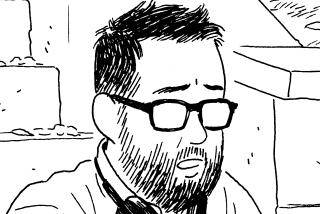Three cartoons: ‘Uncle Grandpa,’ ‘Doctor Lollipop,’ ‘King Douglas’
Although (and also because) they exist at the margins of what we talk about when we talk about television -- cable drama eating up most of that air, unfairly -- cartoons are among the most original, personal, forward-looking and also historically conscious works the medium has to offer. And much as advances in home-recording technology democratized music, better and more affordable animation software has helped open up TV, in its coat of many platforms, to new and independent voices. Cartoons play with form and color, with music and sound in often exciting and unpredictable ways; they go crazy and make impossible worlds; they show the hand of their creators, most literally.
Here are three (fairly) recent excellent adventures in animation. They represent a range of endeavor, budget and venue: conventional television, Web (organized) and Web (self-posting). Coincidentally, they share two-word titles, each of which names and describes their main character: “Uncle Grandpa,” “Doctor Lollipop,” “King Douglas.” All have made me happy.
The first clip (above) is from the free-associating “Uncle Grandpa,” launched by Cartoon Network in September while I was temporarily blinded by the new fall season, and recently picked up for additional episodes. Created by Peter Browngardt (“Secret Mountain Fort Awesome”), it has a kind of kitchen-sink, thrift-store, roller-disco aesthetic -- late Jay Ward pumped up with tertiary Day-Glo colors and magazine clippings, with maybe a bit of Jim Woodring mixed in. It also reminds me a bit of late Philip Guston, which I’m sure was the intention of nobody at all.
The cartoon is a carnival of nonsense and dream sense. Uncle Grandpa (voiced by Browngardt) is everyone’s uncle and also everyone’s grandpa. He goes about in a bigger-on-the-inside RV, accompanied by his talking belly bag, a sentient slice of pizza, a dinosaur bodyguard and a giant realistic flying tiger named Giant Realistic Flying Tiger, represented photographically (but for the rainbow jet trail she leaves behind her). He wears a helicopter beanie and what look like lederhosen and has a detachable, swappable head, with a detachable, swappable nose; other parts are liable to pop off, as well, or an extra arm may appear from the cleft in his impressive chin. Sometimes there are two or more of him.
The clip directly below is the so-far single episode “Doctor Lollipop,” created by “Miss Kelly Martin” and based on her self-published comic book. Directed by Aliki Grafft (“Phineas and Ferb”), it’s available via Frederator Studios’ YouTube channel, Cartoon Hangover. Frederator is an independent animation studio whose TV cartoons, including “The Fairly OddParents” and “Fanboy and Chum Chum,” have aired mostly over Nickelodeon and Nicktoons; the single, signal exception is “Adventure Time,” on Cartoon Network, whose creator Pen Ward, is also behind the Cartoon Hangover series “Bravest Warriors.”
Doctor Lollipop (Chris Diamantopoulos) is a pink unicorn -- and a doctor -- in a forest of talking animals and storybook characters; he is attended in his work by a raccoon (voiced by Rose McGowan), a rabbit and a trio of little birds. In this short, he treats a raptor that has strayed into the woods and is eating everything in sight; stomach distress ensues. “Will I be using the bird anesthetic or the reptile,” asks the nurse-rabbit in a nice dinosaur joke. “Let’s get medical!” Doctor Lollipop cries when it’s time to get medical.
The palette is pastel with some attractive Marimekko patterning in the foliage. As with “Uncle Grandpa,” the awkward and garish Saturday morning cartoons of the 1970s and ‘80s, with their early touch of the Japanese, have influenced contemporary animation and graphic arts (in a good way) as much as Disney, Fleischer, Avery and Jones influenced earlier generations. (There will be rainbows.) There’s an affectionate ironic regard in the borrowings, as is often the case nowadays when low culture is referenced or remixed. (The late Mike Kelly is the fine artist who comes to mind here.) Mixing the heroic and the banal is, of course, the defining comic attitude of the pre- and post-millennium.
A short interview with Martin and Grafft and some deleted scenes (or deleted seconds, really) are here.
I came to the wholly independent, Flash-animated “King Douglas,” which also lives on YouTube, via a Facebook posting by the musician Howe Gelb (of Tucson’s Giant Sand and divers solo works and collaborations), some of whose piano music is featured on the soundtrack, along with works by John Cage and Erik Satie -- setting a downbeat mood unusual for a cartoon. It seemed less unusual when I learned that creator Wyatt O’Connell, now 16, is the son of Kristin Hersh (of Boston’s Throwing Muses and divers solo works and collaborations), who is also the voice of King Douglas. (Other family members round out the cast.)
King Douglas and his more aggressive friend General Miles are two kids who have created a nation, Lotvakia, from an empty lot and a citizenry from a jar of fish. They are pretending, and they are not pretending. In the first episode, which lasts all of 4½ minutes, they research ways to create a tourist economy and face an imperialistic challenge from Roderick Sliit, Sovereign Minister of Superia.
“We will fight you bare-handed until our knuckles shatter,” Miles responds. “Then we will strangle you with the waistbands of our pants; then, when you make fun of us for being pantless... “ At which point he is interrupted.
In the second episode, which is even shorter, the new enemies attempt, without success, to face off.
“Douglas has a bit of internal conflict about whether or not Roderick should be able to fulfill his agenda,” O’Connell wrote in an email, answering my request for background. “I’m attracted to internal conflict which contrasts with rather than compliments external struggles.”
Kids!
The animation is limited even by the stands of limited animation, and the art has a compass-and-protractor look, but these qualities fit the theme and work in its favor: It is a homemade show about a homemade country. And for all its visual simplicity, its rhythms are seductive and its language sophisticated; it has its own special verbal music (the music of a precocious teenager, I suppose) and goes interesting places without fuss. Had I received a screener of this series in a package from Cartoon Network or Nickelodeon, I would have accepted it as an eccentric adult work, a departure even from the usual less-beaten paths. In any case, it is just to my taste.
O’Connell has written a third episode; the second ends with Douglas and Miles sitting in an airport, waiting to fly to Superia. “But I have to wait for my whole cast (read: family) to be together, which should be around Christmas.”
More to Read
The complete guide to home viewing
Get Screen Gab for everything about the TV shows and streaming movies everyone’s talking about.
You may occasionally receive promotional content from the Los Angeles Times.







